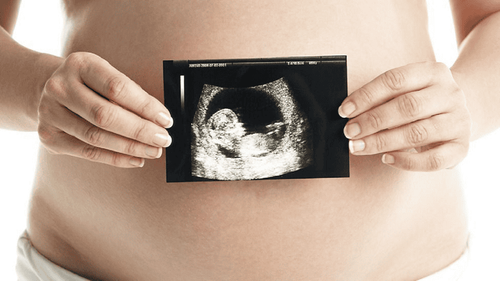This is an automatically translated article.
Stitching to narrow the cervical opening during pregnancy does not affect the development of the fetus and is done quite quickly. The method of closing the cervical opening is to prevent miscarriage such as: pregnant women with cleft palate, women with a history of preterm birth due to cleft palate in previous pregnancies, with a history of cervical stitches. bow...1. What is cervical ostomy?
Cervical incision, also known as cervical suture, is a procedure to stitch the uterus with Mercilene thread to prevent miscarriages such as: pregnant women with cleft uterus, pregnant women with a history of preterm birth due to cleft. isthmus in previous pregnancies, there is a history of cervical suture...Isthmus is performed when there is a cleft in the uterus through imaging (ultrasound shows the length of the cervical canal ≤ ) 25mm, the diameter of the cervical opening is ≥ 8mm wide); have a history of miscarriage with special characteristics of cleft palate (recurrent miscarriage 2-3 times or more, gestational age in the middle 3 months of pregnancy, gestational age for the next miscarriage is smaller than the previous one, rapid miscarriage, pregnancy at miscarriage) is still alive but because it was too preterm, then died) or miscarriage, premature birth before 28 weeks ≥ 2 times in a row with the characteristics of rapid labor without pain.

Khâu vòng thu hẹp lỗ cổ tử cung nhằm dự phòng sảy thai
The time for suturing the uterus is 14 - 18 weeks of gestation and should be stitched before the age of the last miscarriage.
2. The process of stitching the ring to narrow the cervical opening
2.1. Preparation The performer: The performer is a trained obstetrician and gynecologist and the assistant team will explain the purpose of sutures, possible complications after suturing the uterus to the mother and her family first. when there is a decision on stitching Means and instruments: Betadine solution; specialized sutures (Perlon, Mercilen 5mm wide...); Vaginal valve Patient: Sanitized; lying in gynecological position 2.2. Steps to take Step 1: Expose the cervix. Antiseptic, clamp pull the cervix to the outside.Step 2: Stitch the loop
Needle poke at 11:30, exit at 9:30, then poke at 8:30 down to 7:30, poke at 5:30 and up at 3:30; finally poke at the 2:30 position up at 12:30. Tie the thread at the 12 o'clock position Cut the tip just 1cm from the tie Step 3: Check the knot
Disinfect the vagina, cervix Check the knot , two stitches will narrow and narrow the cervical opening in both vertical and horizontal directions. 2.3. Post-procedure follow-up Leave the patient in bed for 12-24 hours Follow-up after uterine contractions, abdominal pain, vaginal bleeding Withdrawal of gauze after 4-6 hours Antibiotic treatment (oral) and antispasmodic The pregnant woman is discharged from the hospital after 24 - 48 hours if there is no uterine contraction, abdominal pain, vaginal bleeding Instruct the mother not to have intercourse, not to stand for a long time, not to exert herself. Cervical length ultrasound at every routine examination Use Progesterone continuously up to 36 weeks of gestation Instructing pregnant women to be re-admitted to hospital when: uterine contractions, vaginal bleeding, amniotic fluid, Thread removal when pregnancy is ≥ 38 week or during labor 2.4. Possible complications Bleeding: usually stops bleeding (except in case of undetected blood disease) 3-4 hours after inserting gauze to stop bleeding Infection: because the procedure is conducted in the absence of blood pressure. Ensure instrument hygiene, or pregnant women have genital infections that have not been completely treated. Broken needles into the cervix: should use large round needles with small curvatures Bladder damage Breaking membranes, or leaking premature membranes Inflammation Amniotic membrane Premature labor Cervical tear Difficult birth due to cervical fibrosis, fibrous scars Uterine rupture
3. What should be done after suturing the cervical spine?

Khám thai theo hướng dẫn của bác sĩ
Minimize movement, move at least within For the first week, it is best to just lie down on the bed to rest, especially if there is a history of miscarriage, premature birth before. In addition, a suitable diet for pregnant women (with full essential nutrients such as protein, starch, fat, vitamins and minerals) should also be concerned and implemented. Absolutely abstain from sex during pregnancy during this time. Prenatal check-ups and ultrasounds to measure the length of the cervix regularly and can continue to use progesterone until the 36th week of pregnancy. When the due date is near (more than 38 weeks), the mother must have sutures removed before the pregnancy. signs of labor to avoid cervical rupture. However, in cases of force majeure such as early labor, the sutures will be cut early to avoid tearing and breaking the cervix due to sutures during labor. The method of cervical suture to prevent premature birth or consecutive miscarriage at Vinmec International General Hospital is applied to pregnant women with a diagnosis of cervical insufficiency; have a history of cervical suture and some special cases such as: twin pregnancy, multiple pregnancy with cervical length less than 25 mm... Advantages of performing a loop stitch to narrow the cervical opening at Vinmec include :
Professional services: Modern civilized disease prevention system, comprehensive care, meals, rest, exercise, health education, each room is equipped with amenities like an apartment 5 star hotel, patient information is confidential. Vinmec's Hybrid operating room is the most modern operating room system in the world today, integrating the operating room and advanced imaging facilities (CT, MRI, ultrasound...) to help reduce time. surgery and bring the best surgical effect to the patient. In anesthesia resuscitation, Vinmec adheres to anesthetic protocols, anesthesia safety guidelines, anesthesia checklists for 100% of surgeries to minimize incidents and unwanted effects.
Please dial HOTLINE for more information or register for an appointment HERE. Download MyVinmec app to make appointments faster and to manage your bookings easily.













